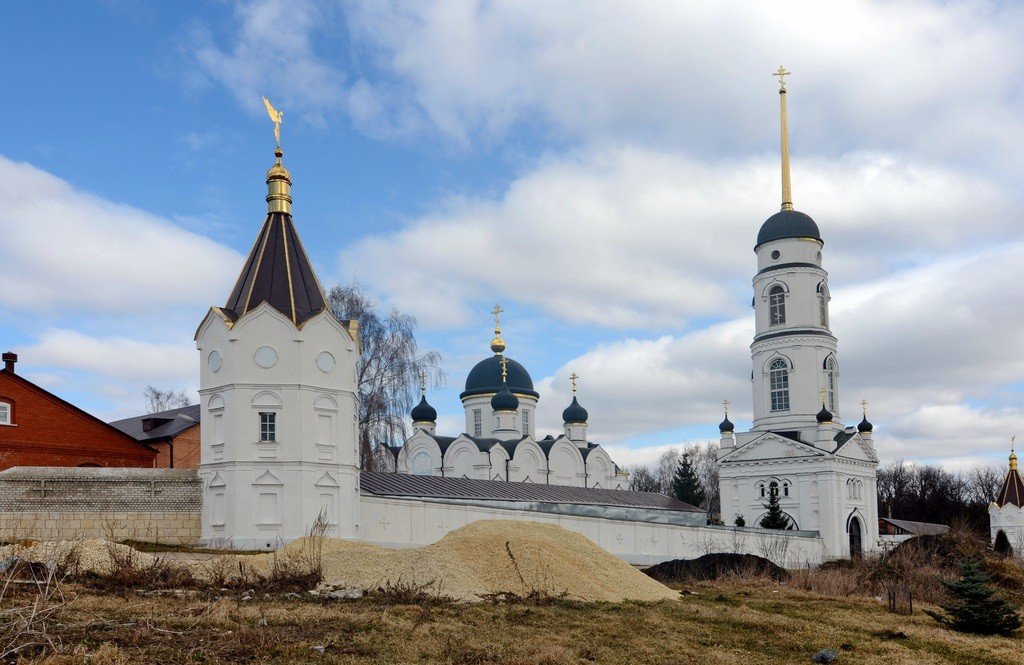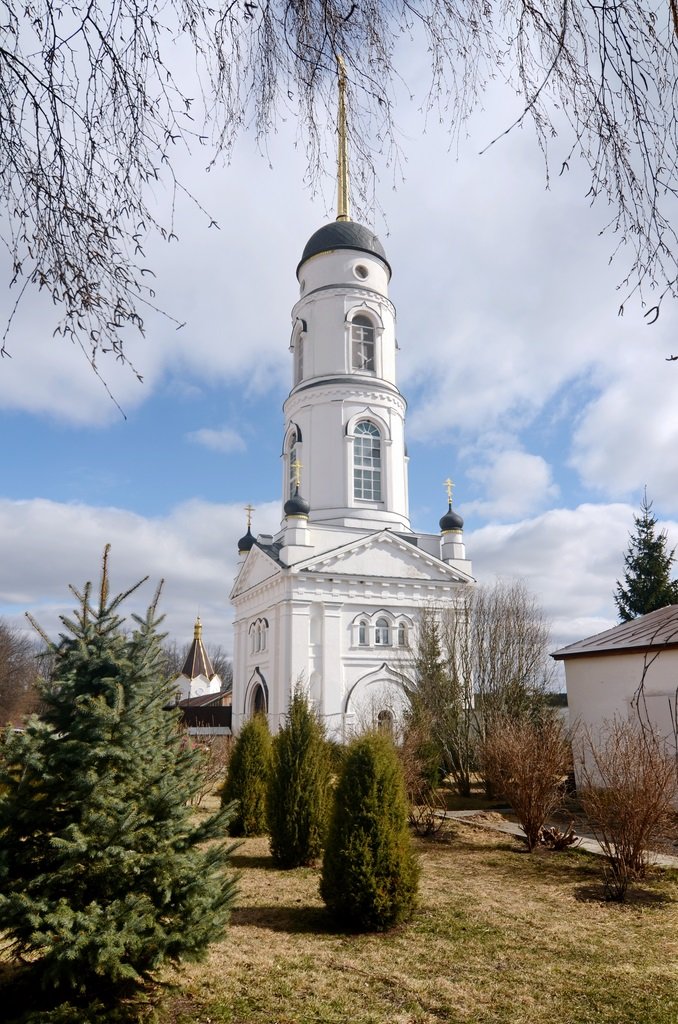
 Contents
ContentsHighlights
Today, the well-restored complex of St. Tikhon’s Transfiguration Monastery attracts many believers and tourists. Its heart is considered the majestic Trinity Church, built in 1883 according to the typical project of the famous Russian architect Konstantin Andreyevich Ton. The picturesque five-domed church has two temples – upper and lower. In 2007 it was completely restored and painted. Next to it rises an overgate four-tiered bell tower and the Transfiguration Church.
.In memory of the wonderworker Tikhon, a memorial cell was built in the eastern tower of the monastery. In addition, the saint is reminded of the spring, for water to which many believers and tourists come.
.
In our monastery territory flowerbeds were laid out, ornamental shrubs were planted. Today the monastery is home to 115 nuns. St. Tikhon’s Transfiguration Monastery owns 200 hectares of land and agricultural machinery. The nuns maintain a cowshed and chicken coop, work on vegetable gardens, and also work in sewing and icon painting workshops. There are regular church services and three times a year hold a procession to the holy spring.
.
Travelers arriving at the monastery can eat in the monastery refectory and stay overnight in the hotel for pilgrims. There are guided tours of the monastery’s grounds for tour groups.
History of St. Tikhon’s Transfiguration Monastery
The history of St. Tikhonovsky Transfiguration Monastery began in 1865 with the erection of a secluded skete of the Monastery of the Virgin Mary. According to legend, the hermitage for the monks began to be built in a place that was very much liked by Tikhon of Zadonsk, who was revered by the faithful.
The saint lived in the Bogoroditsky monastery and liked to come to one corner of the nearby forest, speaking of it as an earthly paradise. With his own hands he dug a deep well in the forest. When Tikhon died in 1783, the inhabitants of the surrounding villages and hamlets began to come to the forest well for water. Water from it was considered curative, they drank it and took it to cure various ailments.
.
The monastic hermitage was built by Archimandrite Dmitry with the blessing of the local diocese. First, in the forest built a wooden three-priest church and consecrated it in honor of Tikhon of Zadonsk. And then a two-story cell block appeared near the church.
.At the beginning of the last century in the monastery lived about a hundred monks and novices. After the advent of Soviet power, the Holy Transfiguration Monastery, like most monasteries in the country, was closed. Church books and liturgical utensils disappeared from it. In different years, the old buildings housed a psychoneurological boarding school, a school for troubled teenagers, a military unit, a hospital and a reconnaissance school.
.
The territory of the monastery was returned to the believers in 1991. Then on the territory of the former male monastery created a convent. After that, the restoration of monastery buildings and temples began.
.
The Holy Spring
Hundreds of pilgrims and tourists come to St. Tikhon’s Transfiguration Monastery to visit the holy spring named after Tikhon of Zadonsk. Near it stands a small beautiful chapel. The one-story brick building has the shape of a cube and is covered with a four-pitched roof, on top of which rises a neat gilded chapter.
.
For the convenience of the faithful in 1994, a small bathhouse was built next to the source. In front of it there is often a queue of those wishing to take a dip in the cool water and heal from ailments.
.
How to get there
The Holy Transfiguration Monastery is located 7 km north of Zadonsk and 62 km southwest of Lipetsk. People get here by shuttle buses running from Lipetsk to Zadonsk. Twice a day, at 7.10 and 14.00, buses from Lipetsk go through the village of Butyrki and pass by the monastery. Other flights go through Kamyshevka, bypassing the monastery. In this case, pilgrims and tourists get to Zadonsk, and then drive up to the Holy Transfiguration Monastery by cab. It should be borne in mind that the cab stand is located next to the Zadonsk bus station.
.St. Tikhonovsky Transfiguration Eparchial Monastery
St. Tikhonovsky Transfiguration Monastery is an active Orthodox women’s monastery in Lipetsk Oblast, located near the town of Zadonsk. In the second half of the 19th century, a male monastery was established near a well dug by St. Tikhon of Zadonsk. It experienced a period of prosperity and in 1920 was closed. In the early 1990s here revived monastic life, and in the old buildings opened a women’s Orthodox monastery.









 Contents
ContentsHighlights
Today, the well-restored complex of St. Tikhon’s Transfiguration Monastery attracts many believers and tourists. Its heart is considered the majestic Trinity Church, built in 1883 according to the typical project of the famous Russian architect Konstantin Andreyevich Ton. The picturesque five-domed church has two temples – upper and lower. In 2007 it was completely restored and painted. Next to it rises an overgate four-tiered bell tower and the Transfiguration Church.
.In memory of the wonderworker Tikhon, a memorial cell was built in the eastern tower of the monastery. In addition, the saint is reminded of the spring, for water to which many believers and tourists come.
.
In our monastery territory flowerbeds were laid out, ornamental shrubs were planted. Today the monastery is home to 115 nuns. St. Tikhon’s Transfiguration Monastery owns 200 hectares of land and agricultural machinery. The nuns maintain a cowshed and chicken coop, work on vegetable gardens, and also work in sewing and icon painting workshops. There are regular church services and three times a year hold a procession to the holy spring.
.
Travelers arriving at the monastery can eat in the monastery refectory and stay overnight in the hotel for pilgrims. There are guided tours of the monastery’s grounds for tour groups.
History of St. Tikhon’s Transfiguration Monastery
The history of St. Tikhonovsky Transfiguration Monastery began in 1865 with the erection of a secluded skete of the Monastery of the Virgin Mary. According to legend, the hermitage for the monks began to be built in a place that was very much liked by Tikhon of Zadonsk, who was revered by the faithful.
The saint lived in the Bogoroditsky monastery and liked to come to one corner of the nearby forest, speaking of it as an earthly paradise. With his own hands he dug a deep well in the forest. When Tikhon died in 1783, the inhabitants of the surrounding villages and hamlets began to come to the forest well for water. Water from it was considered curative, they drank it and took it to cure various ailments.
.
The monastic hermitage was built by Archimandrite Dmitry with the blessing of the local diocese. First, in the forest built a wooden three-priest church and consecrated it in honor of Tikhon of Zadonsk. And then a two-story cell block appeared near the church.
.At the beginning of the last century in the monastery lived about a hundred monks and novices. After the advent of Soviet power, the Holy Transfiguration Monastery, like most monasteries in the country, was closed. Church books and liturgical utensils disappeared from it. In different years, the old buildings housed a psychoneurological boarding school, a school for troubled teenagers, a military unit, a hospital and a reconnaissance school.
.
The territory of the monastery was returned to the believers in 1991. Then on the territory of the former male monastery created a convent. After that, the restoration of monastery buildings and temples began.
.
The Holy Spring
Hundreds of pilgrims and tourists come to St. Tikhon’s Transfiguration Monastery to visit the holy spring named after Tikhon of Zadonsk. Near it stands a small beautiful chapel. The one-story brick building has the shape of a cube and is covered with a four-pitched roof, on top of which rises a neat gilded chapter.
.
For the convenience of the faithful in 1994, a small bathhouse was built next to the source. In front of it there is often a queue of those wishing to take a dip in the cool water and heal from ailments.
.
How to get there
The Holy Transfiguration Monastery is located 7 km north of Zadonsk and 62 km southwest of Lipetsk. People get here by shuttle buses running from Lipetsk to Zadonsk. Twice a day, at 7.10 and 14.00, buses from Lipetsk go through the village of Butyrki and pass by the monastery. Other flights go through Kamyshevka, bypassing the monastery. In this case, pilgrims and tourists get to Zadonsk, and then drive up to the Holy Transfiguration Monastery by cab. It should be borne in mind that the cab stand is located next to the Zadonsk bus station.
.